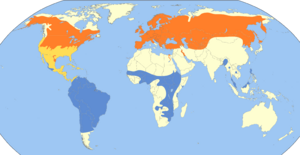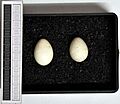Sand martin facts for kids
Quick facts for kids Sand martin / Bank swallow |
|
|---|---|
 |
|
| Flying in Scotland | |
| Conservation status | |
| Scientific classification | |
| Genus: |
Riparia
|
| Species: |
riparia
|
| Subspecies | |
|
|
 |
|
| Range of R. riparia
Breeding Migration Nonbreeding |
|
| Synonyms | |
|
|
The sand martin is a small, brown bird that travels long distances. It's also called the bank swallow in North and South America. This bird belongs to the swallow family.
Sand martins spend their summers in many parts of the world. You can find them across Europe, around the Mediterranean Sea, and all the way to the Pacific Ocean. They also live in North America. When winter comes, they fly south to places like eastern and southern Africa, South America, and India.
Contents
How Scientists Name Birds
Scientists give every living thing a special name. This helps everyone know exactly which plant or animal they are talking about. The sand martin was first described in 1758 by a famous scientist named Carl Linnaeus. He first called it Hirundo riparia.
The word ripia comes from Latin and means "of the riverbank." This is a perfect name because these birds love to live near rivers! There's also a similar bird called the pale martin. It lives in northern India and China. Scientists now consider it a separate species, Riparia diluta.
What Does a Sand Martin Look Like?
The sand martin has a brown back and white belly. It has a thin brown band across its chest. Its beak is black, and its legs are brown. Young sand martins have reddish-brown tips on their wing feathers.
You can tell a sand martin apart from other swallows by its brown back and white throat. It's also quite small and flies with quick, jerky movements. The banded martin, found in Africa, looks similar. However, sand martins only visit Africa in the northern winter.
Measurements:
- Length: 4.7–5.5 in (12–14 cm)
- Weight: 0.4–0.7 oz (11–20 g)
- Wingspan: 9.8–13.0 in (25–33 cm)
When sand martins fly, they make a continuous, chattering sound. Once they settle down, their calls become softer, like a quiet conversation. If a falcon or crow flies by, they make a loud, harsh alarm call. This warns the group to work together to scare the predator away.
Sand Martin Life and Habits
Sand martins are known for their unique nesting habits. They dig long, winding tunnels in sandy hills or riverbanks. These tunnels can be from a few inches to several feet deep! They prefer to nest in soft, sandy soil called loess. You will usually find them near large bodies of water, like rivers, lakes, or even the ocean.
In places like Britain, sand martins are the first swallows to arrive for breeding. They usually show up around the end of March. When they first arrive, they fly alone over water, looking for early insects. Later, they join other swallows, but they stay near large bodies of water for a while. They don't visit their nesting spots right away.
Sand martins leave their breeding grounds early, especially in northern areas. By August, huge groups gather at their nightly roosts. They are usually gone from their breeding areas by the end of September.
Their diet mainly consists of small insects. They especially like gnats and other flies that live near water when they are young.
Sand martins are very social birds when it comes to nesting. Many pairs, from a dozen to hundreds, will nest close together. This depends on how much space is available. At the end of each tunnel, they build a nest. It's made of straw and feathers. Female sand martins lay four or five white eggs around mid-to-late May. They often have a second group of chicks later in the season.
Globally, the sand martin is not considered rare. The IUCN lists it as a species of "least concern." This means it's not currently in danger of disappearing. However, its numbers are decreasing in some areas. Some populations have special protections. This is because they face threats like losing their habitat. For example, in Canada, the sand martin is listed as a threatened species. This is due to a big drop in its population over the last 40 years.
Gallery
-
Adult at nest site, Dziwnówek, Poland







